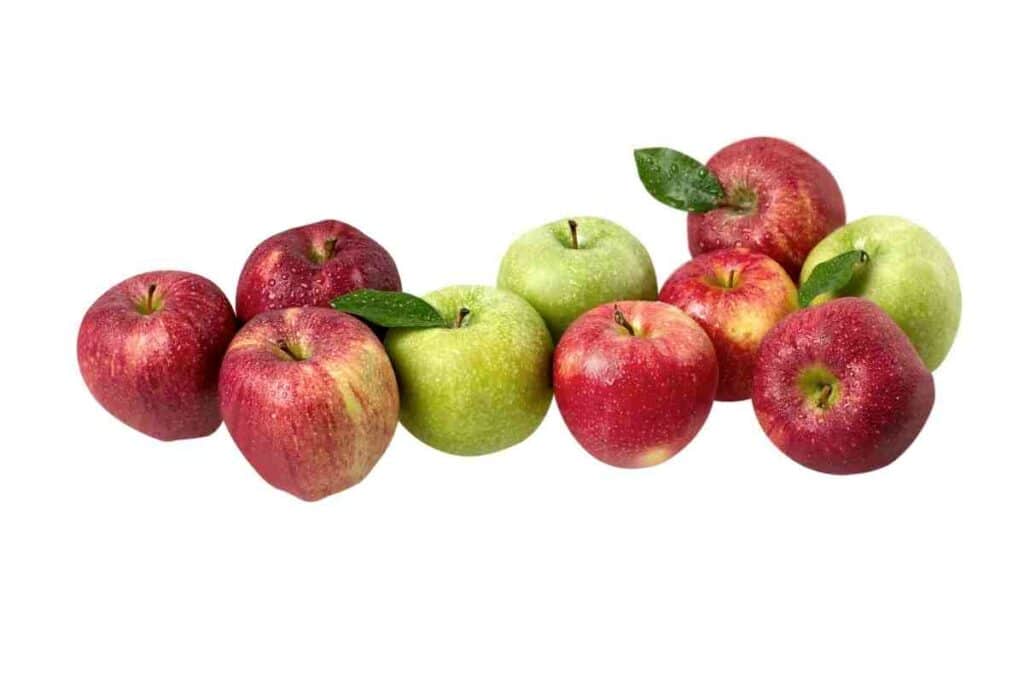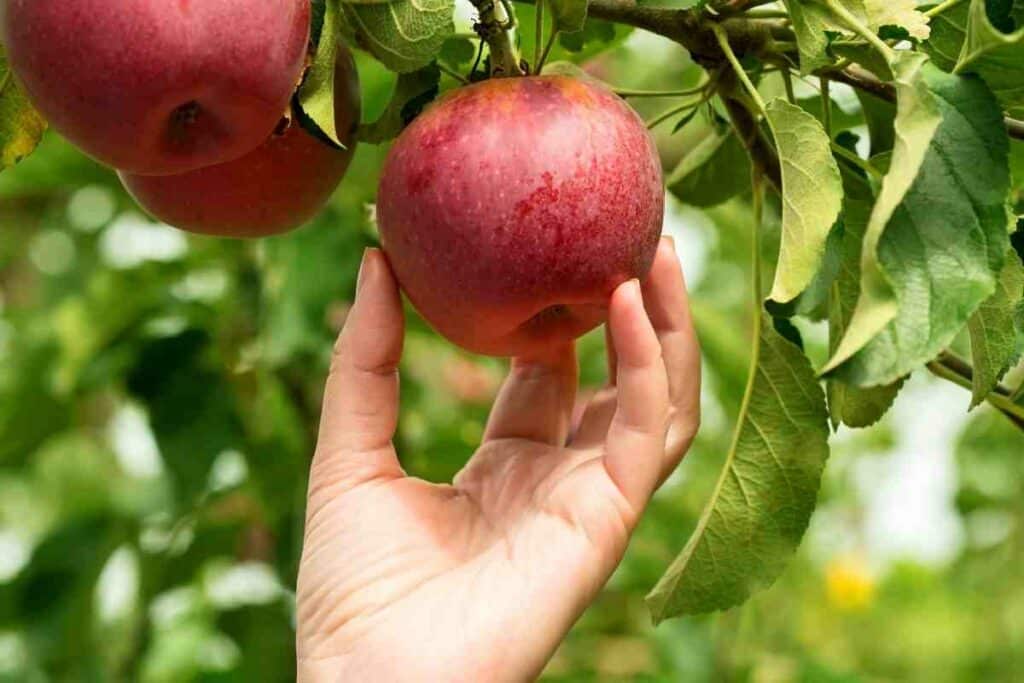Thousands of years ago, apples were selectively bred from Malus sieversii; the wild parent of the domesticated apple we know and love.
While it’s a fact that apples are man-made, one aspect is still confusing about them — is an apple a fruit or a vegetable?
A lot of people view apples as fruits and they’re called so in various nutrition blogs. However, many do argue that apples are vegetables.
No matter where you stand when it comes to the classification of apples, there’s no denying that they’re one of the most popular and most consumed edible plant parts across the globe.

Apples are grown worldwide and several species can be stored for year-long use, given the proper conditions are provided.
Yes, apples are widely referred to as fruits, however, the controversy around apples remains very much alive. As such, many of us question whether apples are true fruits or do they belong to the vegetable category.
In today’s article, we’ll cover this topic in detail to get to the bottom of it.
Is An apple a Fruit or Vegetable?
From all possible and acknowledged perspectives, apples are fruits. Thanks to possessing a sweet taste and being produced from ovaries, apples are considered fruits from a botanical and culinary standpoint.
That’s your short answer, now let’s discuss how this conclusion came about.
Are Apples Fruits?
To figure out whether apples are part of the fruit community, we should observe if they have the necessary qualities to be considered fruit from both a botanical and a culinary point of view.
From a Botanical Perspective
To say for sure whether an apple is a fruit or not from a botanical point of view, we should first understand what fruit is. This means we need a clear definition of the class.
Granted, there are many ways to define fruits, but we’ll look at the most common sections of these descriptions.
For example, the Computer Science department of McGill University in Canada defines fruits as: “In botany, a fruit is the ripened ovary – together with seeds – of a flowering plant […] In many species, the fruit incorporates the ripened ovary and surrounding tissues.”
So, does an apple fit such a definition of a fruit? Well, yes.
Apples are generated from the ripened ovary of a flowering plant. They also contain seeds.
Additionally, apples match the last bit of the above definition as they form from the ripened ovary along with a few of the surrounding tissues.

When fruits are developed from the ripened ovary as well as other parts of the flower, they’re referred to as false fruits.
Valencia College explains the nature of false fruits as follows: “Some fruits, such as apples and strawberries, consist of other flower parts in addition to the ovary or ovaries.
For example, the calyx itself may become fleshy and comprise more extensive fruit tissue than the ovary that it surrounds.
A fruit that consists of more than just the ovary is said to have accessory tissue or is called an accessory fruit.
So what can we conclude from the definitions mentioned above? We can safely say that, from a botanical point of view, apples are fruits.
They can be further classified as false or accessory fruits due to the manner they’re generated.
Why are Apples Called False Fruits?
An apple is referred to as false fruit or accessory fruit because it results from a complex fertilization process termed “double fertilization”. This process produces fruits that develop not only from the ripened ovary but also other parts of the flower.
Although they grow abnormally from actual fruits, false or accessory fruits are still fruits; they just have a category of their own.
They usually -but not always- start from various parts of the flower, not the plant’s ovary.
Also, they can form in great amounts even if fertilization hasn’t taken place. Some parthenocarpic fruits don’t even need seeds to develop!
On the other hand, apples start growing from a part of the flower named the thalamus, which is mainly why they’re referred to as false fruits of apple trees.
Unlike the majority of false fruits, however, apples contain seeds that you can cultivate to grow more apple trees.
Besides apples, a few common examples of false or accessory fruits include strawberries, pears, and figs.
From A Culinary Perspective
A lot of the edible parts of plants that are referred to as fruits from a botanical point of view are considered to be vegetables from a culinary standpoint. For example, tomatoes, pumpkins, and cucumbers are botanically fruits but culinary vegetables.
Now, let’s see what an apple is regarded as in culinary arts. Luckily, the definition of fruit from a culinary perspective is rather straightforward.
In culinary terminology, an edible plant part is said to be a fruit if it has a sweet taste by nature, especially if we’re talking about a botanical fruit.
On the other hand, a vegetable in culinary arts is an edible plant part that possesses a less sweet or savory taste.
According to this information, apples are considered fruits from a culinary outlook because they generally taste sweet.
Are Apples Vegetables?
Up until now, we’ve established that apples are fruits from both a botanical and culinary perspective. It’s time to see if we can also consider them vegetables.
To do this, we need to understand what a vegetable is. Unlike fruits, there’s no clear definition for vegetables in botany.
ScienceDaily says that the term “vegetable” is just a culinary word with no scientific value. According to their website, what’s considered a culinary vegetable is somewhat subjective and arbitrary.
Culinary arts perceive any parts of herbaceous plants that humans consume for food -whether whole or part- as vegetables. For example, mushrooms are biologically fungi but are commonly referred to as vegetables from a culinary viewpoint.
Fortunately, the Division of Agriculture and Natural Resources of the University of California offers a clearer description of vegetables as follows: “Vegetable, the edible product of a herbaceous plant-that is, a plant with a soft stem, as distinguished from the edible nuts and fruits produced by plants with woody stems such as shrubs and trees.”
So, by definition, products of woody-stemmed plants such as trees and shrubs aren’t considered vegetables. Since apples come from apple trees, we can say that they’re not vegetables.
Additionally, if we consider the culinary identification of fruits depending on the sugar level they offer, then apples are fruits because they taste sweet, not vegetables because they’re not savory.
Deriving from all that we discussed in this article, we believe it’s only fair to classify apples as fruits, not vegetables.
Wrap Up
From all possible and acknowledged perspectives apples are fruits, not vegetables.
Thanks to possessing a sweet taste and being produced from ovaries, apples are considered fruits from a botanical and culinary standpoint.
What’s more, apples can be further classified as false or accessory fruits because they’re formed from other parts of the flower along with the ripened ovary.
Despite the controversy surrounding apples, they’re extremely popular worldwide. They are eaten raw or as an ingredient in pies, tarts, and dishes.
Apples are also used in manufacturing various beverages, baby food, and other products like candy. Not to mention, these fruits can be beneficial health-wise.